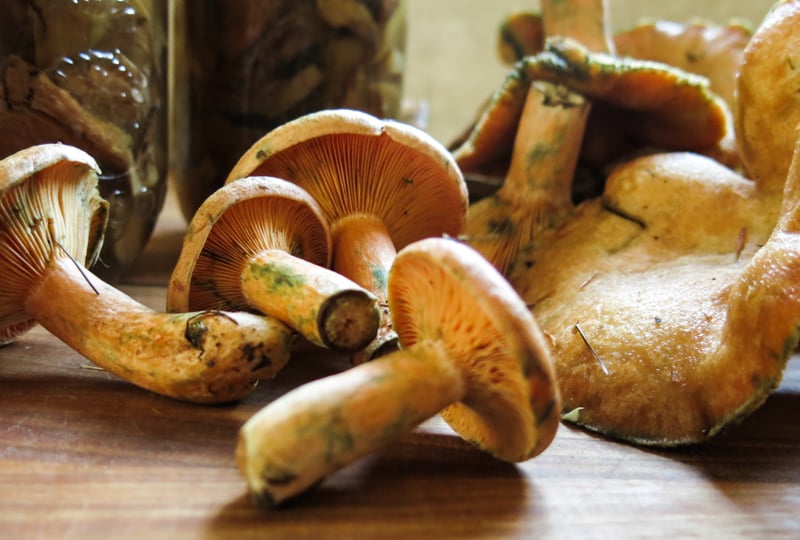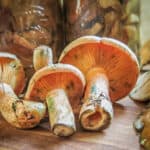When you read about preserving milkcap mushrooms, you might read about salting, fermenting or brining, which if you're not already an intrepid experimenter can sound like some strange wizardry.
One of my favorite things to do with mushrooms is to pickle them, after which I add them to salads, stir fries, and whatever else I want, they're not something I generally serve cold, rather pickling is the best way to keep the texture of fresh mushrooms.
I use the pickles just like I would fresh, taking into account the fact that they will have a little bit of a bite, which can be just what the doctor ordered sometimes.
Pickling saffron milk caps, also known as niscalos or rovellones in Spain, is also traditional. When my little sister studied abroad in Catalonia, she and her host mother went out to pick wild mushrooms to pickle, and they sent me a recipe. I adapted it a bit here, so feel free to adjust the seasonings to your taste.

Pickled Saffron Milk Caps
Equipment
- 2 Pint mason jars
Ingredients
- 1 lb young saffron milk cap mushrooms
- 3 cups water
- 1.5 teaspoon salt
- 1-2 large cloves of garlic
- A few sprigs of fresh thyme
- Two dried bay leaves
- 1 cup of champagne or white wine vinegar
Instructions
- First trim and clean your mushrooms. Ideally you'll have buttons that you can pickle whole.
- Bring the water, salt, garlic, and herbs to a boil in a large pot. Add the mushrooms, cover and cook until the mushrooms are wilted and cooked through, about 5-10 minutes
- When the mushrooms are cooked, add the vinegar
- Lastly, pack your canning jars full of the mushrooms and then top the jars off with the pickling liquid
- If you want to process them in a a water bath canner, you can do so for 15 minutes.


Polygon Bridge
Thank you so much for sharing this wonderful post with us.
Alan Bergo
Thanks.
Rick K
When I was a youngster, I used to pick Honey mushrooms with my dad. My mom would pickle them and I loved those slippery little mushrooms. I was looking for a good Pickle recipe. Now I have one. How long will the mushrooms last if canned and hot bathed? Can you get a year out of them?
Thanks
Alan Bergo
You can definitely get a year out of them.
Isabella Roversi
This looks awesome Alan. Right now there's a ton of Lactifluus hygroforoides in my area... think they would work?
Alan Bergo
I haven't tried it with them specifically but I have friends that like them. I'd blanch the before putting in the jars, if they get slippery I'll rinse them before using them.
Isabella Roversi
Sounds like a plan! I'll report back. Thank you!
Nauru wycieczki
Good website! I really love how it is easy on my eyes and the data are well written. I am wondering how I could be notified when a new post has been made. I have subscribed to your RSS feed which must do the trick! Have a nice day!
Alan Bergo
There is a subscribe widget on the top lefthand corner of the homepage, let me know if you don't get updates and I'll keep working on it. I'm pretty new to wordpress-A